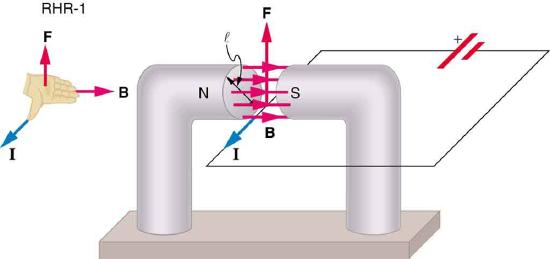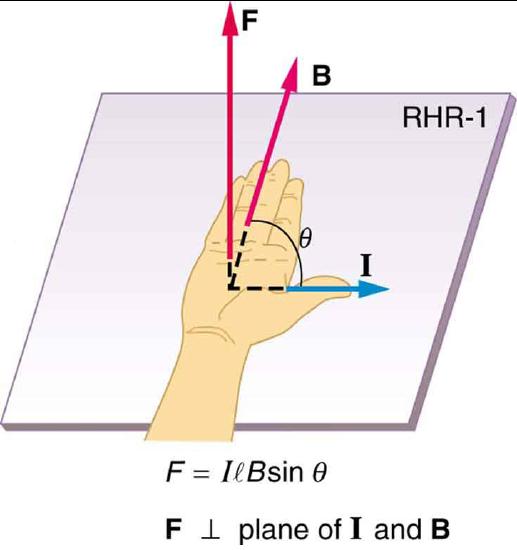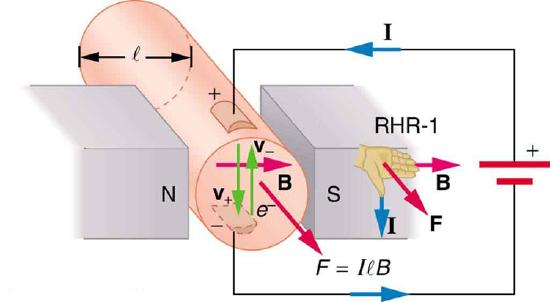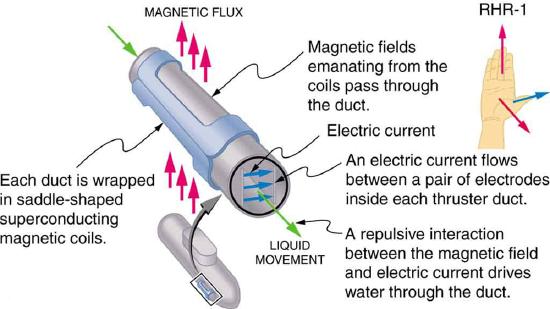9.6: Magnetic Force on a Current-Carrying Conductor
- Page ID
- 47064
Learning Objectives
By the end of this section, you will be able to:
- Describe the effects of a magnetic force on a current-carrying conductor.
- Calculate the magnetic force on a current-carrying conductor.
Because charges ordinarily cannot escape a conductor, the magnetic force on charges moving in a conductor is transmitted to the conductor itself.

It can therefore be shown that the force on a current-carrying conductor is given by the expression
\[F = IlB \label{22.8.1b}\]
where \( I \) is the current, \(l\) is the length of the conductor, and \(B\) is the strength of the magnetic field. The direction of this force is given by RHR-1, with the thumb in the direction of the current \(I\). Then, with the fingers in the direction of \(B\), a perpendicular to the palm points in the direction of \(F\), as in Figure 2.

Magnetic force on current-carrying conductors is used to convert electric energy to work. (Motors are a prime example—they employ loops of wire and are considered in the next section.) Magnetohydrodynamics (MHD) is the technical name given to a clever application where magnetic force pumps fluids without moving mechanical parts (Figure \(\PageIndex{3}\)).

A strong magnetic field is applied across a tube and a current is passed through the fluid at right angles to the field, resulting in a force on the fluid parallel to the tube axis as shown. The absence of moving parts makes this attractive for moving a hot, chemically active substance, such as the liquid sodium employed in some nuclear reactors. Experimental artificial hearts are testing with this technique for pumping blood, perhaps circumventing the adverse effects of mechanical pumps. (Cell membranes, however, are affected by the large fields needed in MHD, delaying its practical application in humans.) MHD propulsion for nuclear submarines has been proposed, because it could be considerably quieter than conventional propeller drives. The deterrent value of nuclear submarines is based on their ability to hide and survive a first or second nuclear strike. As we slowly disassemble our nuclear weapons arsenals, the submarine branch will be the last to be decommissioned because of this ability (Figure \(\PageIndex{4}\)). Existing MHD drives are heavy and inefficient—much development work is needed.

Summary
- The magnetic force on current-carrying conductors is given by \[F = I l B \] where \(I\) is the current, and \(l\) the length of a straight conductor in a uniform magnetic field \(B\). The force follows RHR-1 with the thumb in the direction of \(I\).
Contributors and Attributions
Paul Peter Urone (Professor Emeritus at California State University, Sacramento) and Roger Hinrichs (State University of New York, College at Oswego) with Contributing Authors: Kim Dirks (University of Auckland) and Manjula Sharma (University of Sydney). This work is licensed by OpenStax University Physics under a Creative Commons Attribution License (by 4.0).


